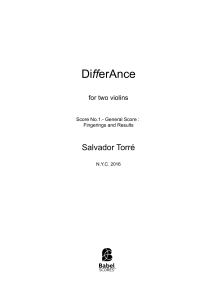Recherche avancée
...aspettando...
ISMN : 979-0-2325-4306-2
- Identifiez-vous pour créer une liste
…aspettando… is a piece for solo alto saxophone that was completed in March 2014 and was commissioned by the Italian saxophonist Michele Bianchini. It lasts a little more than ten minutes, and was based on Samuel Beckett’s play Waiting for Godot (1948).
What influences me the most in Beckett’s work is the extremely well structured eccentric and erratic, though substantial, idiosyncratic atmosphere that lies on all of his works. What amazes me on the specific work, Waiting for Godot, is the monotonous, though tense, scenery that is given by the endless dialogues between Vladimir and Estragon, the two protagonists. I idolize how Beckett maintains this kind of energy throughout the work, though nothing really happens. That is what I tried to achieve with and in my solo saxophone piece; contradiction: localized complexity vs macro-scale simplification and unification.
The solo piece was composed using a wide canvas of small and large gestures that were put in order in a particular way so that sometimes the connection between them does not make any sense. The process I used to achieve this phenomenon was that of breaking gestures in pieces and interfering smaller samples of gestures into other gestures. Consequently, although the local and micro-level may seem awkward and not well connected, the entirety of the structure has a logical momentum. This concept interprets the structural flow of Waiting for Godot, where, even if the essence and the meaning of each local discussion between the two protagonists may be minimal and totally irrelevant to the whole work, there is a macro-scale point that underlies and puts together the entirety of the work’s process (i.e. the fact of waiting for someone who never comes).
Pages - 16











